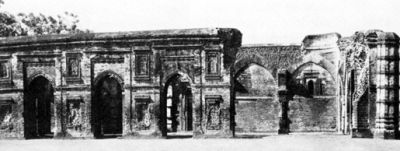Tantipada Mosque
Tantipada Mosque is located in between the lattan mosque on the south and the Chhota Sagardighi on the north within the mud-walled city of gaur, now in the district of Maldah, West Bengal. Mirsad Khan, a high ranking noble of Sultan Yusuf Shah, erected the building, according to an inscription, in 1480.

The mosque, now in ruins, is a large oblong structure and measures externally, inclusive of the four octagonal towers on the exterior angles, 28.65m from north to south and 13.41m from east to west. The mosque is entered through arched-doorways - five in the eastern facade and two each in the north and south sides. The western wall is internally recessed with five semi-circular mihrab niches facing cardinally the eastern entrances. The interior of the mosque, measuring 23.77m by 9.45m, is divided into five bays and two longitudinal aisles by a single row of four stone pillars producing a total number of ten independent square bays. The roof was covered with ten domes, one over each bay. The intersecting arches springing from the stone pillars and blocked-arches over the mihrabs and arched-openings supported these domes. And the phase of transition for the support of the domes was achieved by means of Bengali brick pendentives, traces of which still exist on the upper corners inside the building.
The central mihrab has a rectangular projection outside. The battlements and cornices are gently curved. It is important to note that there was a raised gallery on the northwestern corner inside the building. The existence of a small mihrab niche in the upper part of the western wall just above the northern most mihrab and an arched opening in the upper part of the west end of the north wall is corroborative to this fact. This upper arched-opening must have served as a door to the raised-gallery from a staircase platform on the exterior side - an architectural device noticed in a number of Bengal mosques such as the adina mosque at Pandua, the darasbari and chhota sona mosques in Gaur, Nawabganj.
The mosque was originally decorated with exquisite terracotta ornamentation, much of which has already disappeared. The eastern facade is variegated with offsets and recesses - the offsets being marked with a pair of large panels, one above the other and the recesses forming frame-like rectangles contain the archways within. The panels, having scroll borders in high relief, are filled with floret designs and pendant motifs hanging from the apex of the arches. Similar decorative panels are also seen in the facets of the octagonal corner towers. The soffits of the doorway arches are embellished with small rosettes, while their spandrels are richly adorned with vine-like scrolls with rosettes rising out of the vases below.
All the mihrabs are elegantly decorated, each being enclosed with a rectangular frame. These frames were filled with varieties of designs, and topped by tiers of mouldings crowned with rows of blind merlons. Still higher up there is a boldly projected medallion-like sun. The interior of the mihrab niches is divided into panels, each ornamented with a cusped arch and a hanging motif.
Considering the graceful ornamentation and the perfection of architectural details the Tantipada Mosque has been regarded as the finest edifice in Gaur. [MA Bari]
Bibliography H Creighton, The Ruins of Gaur, London, 1817; H Ravanshaw, Gaur Its Ruins and Inscriptions, London, 1878; Abid Ali Khan, Memoirs of Gaur and Pandua, Calcutta, 1931; G Mischell (ed), The Islamic Heritage of Bengal, Paris, 1984.
